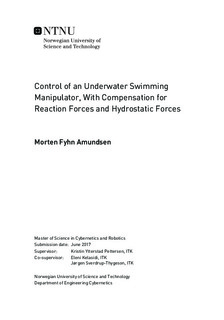| dc.description.abstract | The underwater swimming manipulator (USM) is a new class of robots that combines the underwater snake robot's biologically inspired shape with the thruster actuators typical of other underwater robots. This combination makes USMs highly flexible and facilitates for inspection, maintenance, and repair in otherwise inaccessible environments. However, because the USM floats freely in the water, any motion of the manipulator will cause a reaction that affects the position and orientation of the base, and hydrostatic forces will cause rotations of the entire vehicle. This thesis proposes a USM control scheme that accounts for reaction forces and hydrostatic forces. The approach is based on a method originally developed for robots in space, using the generalized Jacobian matrix. The generalized Jacobian takes base-manipulator coupling into account and allows manipulation without actuating the base coordinates. Applying this to a USM differs from previous USM control methods, which actively control the base link to allow fixed-base control of the end-effector. The previous methods require many thrusters, and the power to drive them. This thesis investigates if USM control with the generalized Jacobian is feasible, despite the differences between underwater and space robots. The complete control system is implemented in MATLAB/Simulink and verified in the Vortex Studio real-time hydrodynamic simulator. Without hydrostatic forces, the system is found to be useful even without sensor feedback, with small tracking errors. With nonzero hydrostatic forces, sensor feedback is required for acceptable accuracy, and position feedback was found to give significantly better precision than velocity feedback. The thesis demonstrates that the generalized Jacobian can be used for efficient USM control, and is applicable to any underwater vehicle manipulator system, including underwater snake robots without thrusters. For USMs, this means that longer missions on battery power are possible and that the thrusters are freed to other tasks. | |

